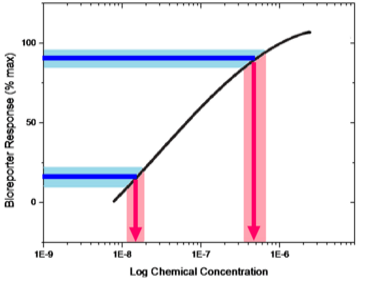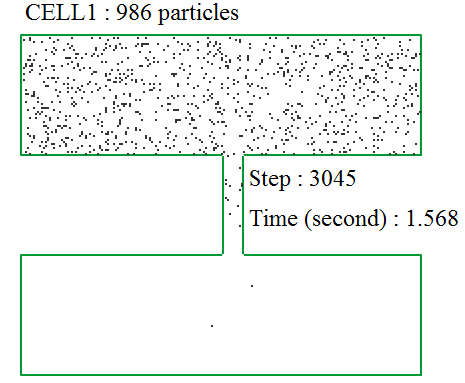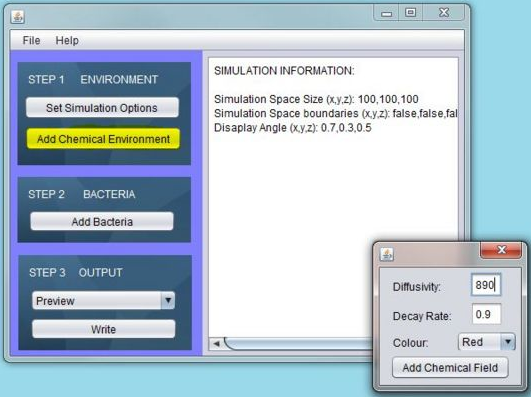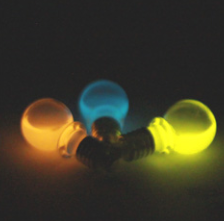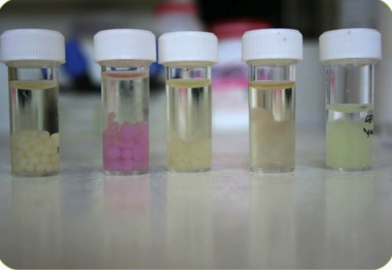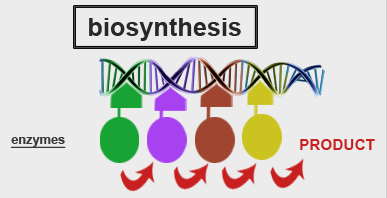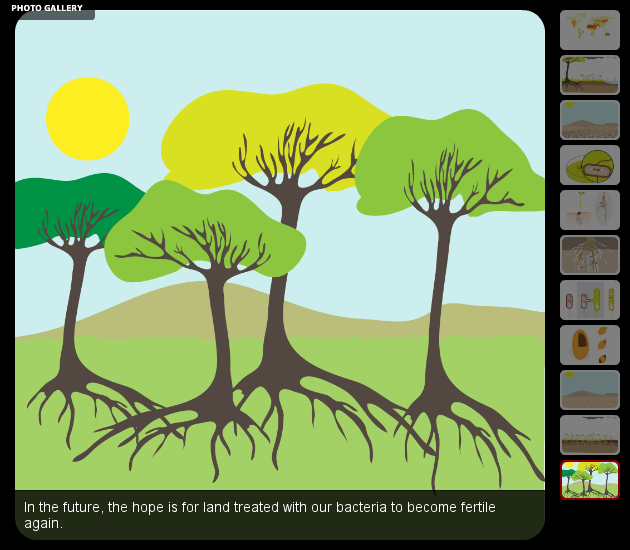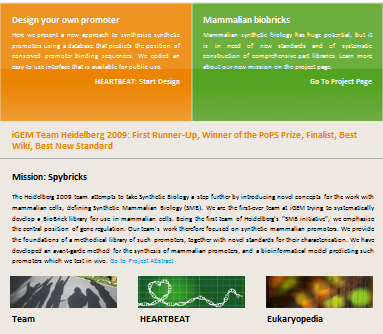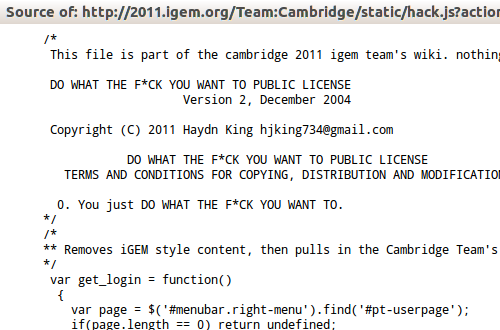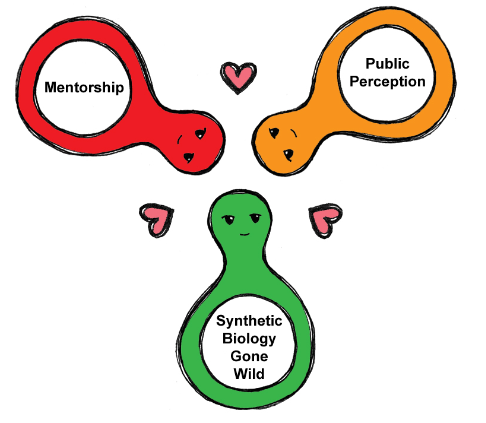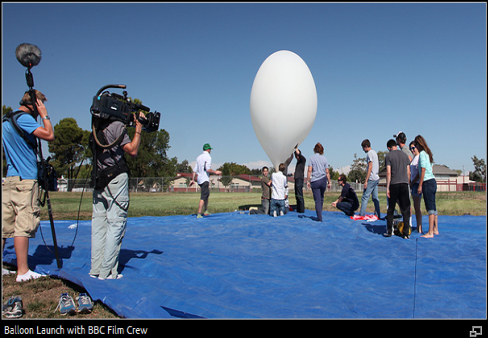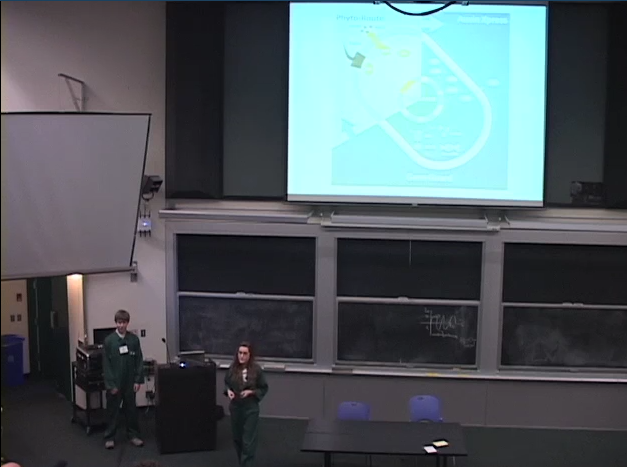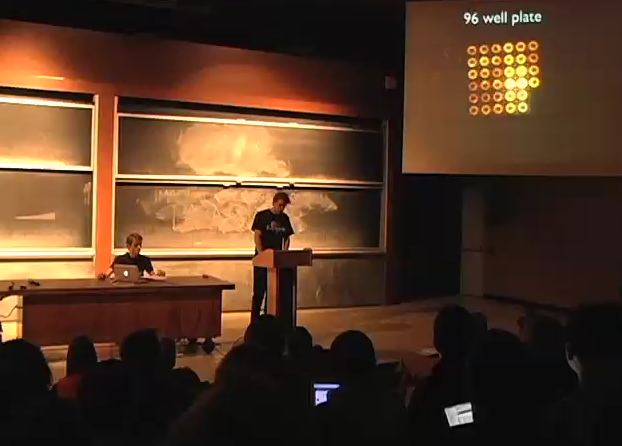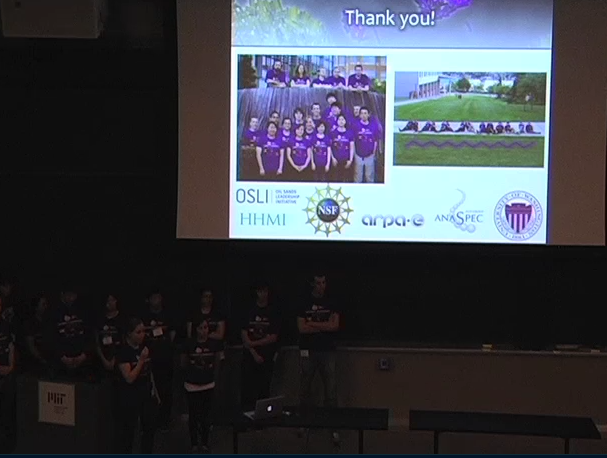Team:Peking/HumanPractice/HistoriciGEMProjectsReview
From 2012.igem.org
m |
m |
||
| Line 49: | Line 49: | ||
<h3 id="title1" class="w">Summary</h3> | <h3 id="title1" class="w">Summary</h3> | ||
<p style="width:465px;"> | <p style="width:465px;"> | ||
| - | + | Sharing and learning from each other is one of the most important figures for iGEM competition, in that any lack of experience could be well ameliorated by studying the projects and the way of presenting them of other and/or previous teams. | |
| + | <br /> <br /> | ||
| + | We here present you with a collection and praise of historic iGEM projects. Though these projects selected may not comprehensively include all the meritorious projects of each aspect, we managed to introduce you some representative projects from different perspective. And we hope this collection might help iGEMers with their projects and presentations. | ||
</p> | </p> | ||
</div> | </div> | ||
| Line 105: | Line 107: | ||
<div class="floatR"> | <div class="floatR"> | ||
<p style="width:600px;"> | <p style="width:600px;"> | ||
| - | + | The first amazing modeling project for you is from Peking 2010 team. As they were endeavoring in the development of a sensing circuit for heavy metals, the linear range should be broad enough to include a change of several magnitudes. Taking an informative Biological Network Reverse Engineering approach to guide the circuit design, they were finally able to enhance the function to a next level. | |
</p> | </p> | ||
</div> | </div> | ||
| Line 124: | Line 126: | ||
<div class="floatR"> | <div class="floatR"> | ||
<p style="width:600px;"> | <p style="width:600px;"> | ||
| - | + | Then it comes to the modeling work of British Columbia of 2011. They have presented an example for an extension of traditional modeling. The protein structure alignment and the docking of the small molecule gave them information on what residues were responsible for the synthesis of terpene and thus for the synthase’s modification. | |
</p> | </p> | ||
</div> | </div> | ||
| Line 143: | Line 145: | ||
<div class="floatR"> | <div class="floatR"> | ||
<p style="width:600px;"> | <p style="width:600px;"> | ||
| - | + | In order to model the core repressilator system, Edinburg 2010 inventively developed a stochastic agent and rule-based language called Kappa. In Kappa, proteins, DNA, and RNA are represented as agents that can be used to hold state or interact with other agents. And with kappa, they are able to assimilate the oscillation of the population of bacteria and the level of proteins. | |
</p> | </p> | ||
</div> | </div> | ||
| Line 162: | Line 164: | ||
<div class="floatR"> | <div class="floatR"> | ||
<p style="width:600px;"> | <p style="width:600px;"> | ||
| - | + | What to taste something more than traditional dynamic modeling? Paris Bettencourt 2010 showed us an outstanding example of kinetic modeling and it came along with a real-time video illustration for readers to directly understand what is going on with the diffusion process. | |
</p> | </p> | ||
</div> | </div> | ||
| Line 181: | Line 183: | ||
<div class="floatR"> | <div class="floatR"> | ||
<p style="width:600px;"> | <p style="width:600px;"> | ||
| - | + | Only developing a set of functional beads is in itself incomplete, as the key to a useful tool is to let others characterize the beads in their own projects. And this originally developed software, BSim, is not only user-friendly, but also perfectly characterizes the behavior of their beads. | |
</p> | </p> | ||
</div> | </div> | ||
| Line 240: | Line 242: | ||
<div class="floatL" style="margin-left:30px;"> | <div class="floatL" style="margin-left:30px;"> | ||
| - | <a href="https://2009.igem.org/Team: | + | <a href="https://2009.igem.org/Team:Cambridge"> |
| - | <img src="/wiki/images/ | + | <img src="/wiki/images/9/98/Peking2012_HumanPractice_Review_Fig7_Cambridge2009.png" alt="" title="Cambridge 2009" style="width:220px;" /> |
</a> | </a> | ||
</div> | </div> | ||
<div class="floatR"> | <div class="floatR"> | ||
<p style="width:600px;"> | <p style="width:600px;"> | ||
| - | + | Colors and light should always be something attractive on an iGEM competition. And the Cambridge team of 2010 and 2009 certainly understand this and take it to their advantage. | |
</p> | </p> | ||
</div> | </div> | ||
<div class="floatL" style="margin-left:30px;"> | <div class="floatL" style="margin-left:30px;"> | ||
<p style="width:220px;text-align:center;font-weight:bold;"> | <p style="width:220px;text-align:center;font-weight:bold;"> | ||
| - | + | Cambridge 2009 | |
</p> | </p> | ||
</div> | </div> | ||
| Line 259: | Line 261: | ||
<div class="floatL" style="margin-left:30px;"> | <div class="floatL" style="margin-left:30px;"> | ||
| - | <a href="https:// | + | <a href="https://2010.igem.org/Team:Cambridge"> |
| - | <img src="/wiki/images/ | + | <img src="/wiki/images/5/57/Peking2012_HumanPractice_Review_Fig8_Cambridge2010.png" alt="" title="Cambridge 2010" style="width:220px;" /> |
</a> | </a> | ||
</div> | </div> | ||
<div class="floatR"> | <div class="floatR"> | ||
<p style="width:600px;"> | <p style="width:600px;"> | ||
| - | + | Their 2010 work of lightening cells with different luciferases and their 2009 work of transmitting different pigments of different colors are both applicable and charming projects for the competition. A simple array of colors and lights would just tell the whole story. | |
| - | + | ||
</p> | </p> | ||
</div> | </div> | ||
<div class="floatL" style="margin-left:30px;"> | <div class="floatL" style="margin-left:30px;"> | ||
<p style="width:220px;text-align:center;font-weight:bold;"> | <p style="width:220px;text-align:center;font-weight:bold;"> | ||
| - | Cambridge | + | Cambridge 2010 |
</p> | </p> | ||
</div> | </div> | ||
| Line 279: | Line 280: | ||
<div class="floatL" style="margin-left:30px;"> | <div class="floatL" style="margin-left:30px;"> | ||
| - | <a href="https://2010.igem.org/Team: | + | <a href="https://2010.igem.org/Team:BCCS-Bristol"> |
| - | <img src="/wiki/images/ | + | <img src="/wiki/images/7/77/Peking2012_HumanPractice_Review_Fig9_BCCS_Bristol2010.png" alt="" title="BCCS-Bristol 2010" style="width:220px;" /> |
</a> | </a> | ||
</div> | </div> | ||
<div class="floatR"> | <div class="floatR"> | ||
<p style="width:600px;"> | <p style="width:600px;"> | ||
| - | + | Now here goes the project of Bristol 2010. The incorporation of engineered E. coli into beads will not only extend the territory of this biobrick, but also will help with possible commercialization. The combination of field application and lab design will always remain the most exciting part of iGEM! | |
| - | + | ||
</p> | </p> | ||
</div> | </div> | ||
<div class="floatL" style="margin-left:30px;"> | <div class="floatL" style="margin-left:30px;"> | ||
<p style="width:220px;text-align:center;font-weight:bold;"> | <p style="width:220px;text-align:center;font-weight:bold;"> | ||
| - | + | BCCS-Bristol 2010 | |
</p> | </p> | ||
</div> | </div> | ||
| Line 299: | Line 299: | ||
<div class="floatL" style="margin-left:30px;"> | <div class="floatL" style="margin-left:30px;"> | ||
| - | <a href="https:// | + | <a href="https://2009.igem.org/Team:Valencia"> |
| - | <img src="/wiki/images/ | + | <img src="/wiki/images/d/da/Peking2012_HumanPractice_Review_Fig6_Valencia2009.gif" alt="" title="Valencia 2009" style="width:220px;" /> |
</a> | </a> | ||
</div> | </div> | ||
<div class="floatR"> | <div class="floatR"> | ||
<p style="width:600px;"> | <p style="width:600px;"> | ||
| - | + | What would happen when electricity meets synthetic biology? Valencia 2009 team presented a wonderful combination of electrical engineering and voltage-sensitive cells. And the idea of iLCD gives a visual impact illustrating the characteristics of their biobrick and the charm of interdisciplinary research. | |
| - | + | ||
</p> | </p> | ||
</div> | </div> | ||
<div class="floatL" style="margin-left:30px;"> | <div class="floatL" style="margin-left:30px;"> | ||
<p style="width:220px;text-align:center;font-weight:bold;"> | <p style="width:220px;text-align:center;font-weight:bold;"> | ||
| - | + | Valencia 2009 | |
</p> | </p> | ||
</div> | </div> | ||
| Line 325: | Line 324: | ||
<div class="floatR"> | <div class="floatR"> | ||
<p style="width:600px;"> | <p style="width:600px;"> | ||
| - | + | DNA scaffold? Aligned proteins? Is ELISA the only way to characterize its function with those boring curves and numbers? The 2010 team of Slovenia said no! Spatially related fluorescent proteins would undergo a process called Fluorescent Resonance Energy Transfer. And seeing the emission of fluorescence sure catches more intention then those curves, right? | |
| - | And the | + | |
</p> | </p> | ||
</div> | </div> | ||
| Line 391: | Line 389: | ||
<div class="floatR"> | <div class="floatR"> | ||
<p style="width:600px;"> | <p style="width:600px;"> | ||
| - | Though text and photos are garbled at the front-page , this wiki enjoys an elegant design in its navigation bar, which is not only informative, but also convenient for users from all kinds of backgrounds. | + | Completely lost when you are looking for some specific information in a wiki? Paris 2011 says a good navigation system would help. Though text and photos are garbled at the front-page , this wiki enjoys an elegant design in its navigation bar, which is not only informative, but also convenient for users from all kinds of backgrounds. |
</p> | </p> | ||
</div> | </div> | ||
| Line 410: | Line 408: | ||
<div class="floatR"> | <div class="floatR"> | ||
<p style="width:600px;"> | <p style="width:600px;"> | ||
| - | Explicit illustration at frontpage not only avoids prolonged texture and makes the whole page more compact, but also eased the tension of serious scientific research. | + | As for the elegant wiki of Washington 2011, people would be touched by first sight. Explicit illustration at frontpage not only avoids prolonged texture and makes the whole page more compact, but also eased the tension of serious scientific research. If you want an eye-catching and informative wiki, this is it! |
| - | If you want an eye-catching and informative wiki, this is it! | + | |
</p> | </p> | ||
</div> | </div> | ||
| Line 430: | Line 427: | ||
<div class="floatR"> | <div class="floatR"> | ||
<p style="width:600px;"> | <p style="width:600px;"> | ||
| - | The introduction of a rotating gallery containing each individual module of the whole wiki also | + | Other styles also convey their stories effectively, such as the wiki of Imperial College London 2011. The introduction of a rotating gallery containing each individual module of the whole wiki also saves space, but this format requires inclusive consideration on timing, picture choosing and more efficient wording |
</p> | </p> | ||
</div> | </div> | ||
| Line 449: | Line 446: | ||
<div class="floatR"> | <div class="floatR"> | ||
<p style="width:600px;"> | <p style="width:600px;"> | ||
| - | The usage of pure-color squares and the combination of carefully aligned, differently sized squares gives out an impression of well organization and explicitness. | + | Aesthetics is another core element come to a wiki constructor’s mind. And the wiki of Heidelberg in 2009 serves as a good example. The usage of pure-color squares and the combination of carefully aligned, differently sized squares gives out an impression of well organization and explicitness. |
</p> | </p> | ||
</div> | </div> | ||
| Line 468: | Line 465: | ||
<div class="floatR"> | <div class="floatR"> | ||
<p style="width:600px;"> | <p style="width:600px;"> | ||
| - | For those teams who wrote their own codes and constructed their own system of wiki, their wiki should be highly appreciated and honored. | + | Well, a wiki does not come out of nowhere. Good coding not only guarantees a good wiki website but also facilitates those who want to learn from the wiki’s construction. For those teams who wrote their own codes and constructed their own system of wiki, their wiki should be highly appreciated and honored. By the way, this year, Peking's Wiki System is also written by ourselves, character by character! |
| - | By the way, this year, Peking's Wiki System is also written by | + | |
</p> | </p> | ||
</div> | </div> | ||
Revision as of 02:47, 6 September 2012
-
-
-
Summary
Sharing and learning from each other is one of the most important figures for iGEM competition, in that any lack of experience could be well ameliorated by studying the projects and the way of presenting them of other and/or previous teams.
We here present you with a collection and praise of historic iGEM projects. Though these projects selected may not comprehensively include all the meritorious projects of each aspect, we managed to introduce you some representative projects from different perspective. And we hope this collection might help iGEMers with their projects and presentations.
-
-
-
-
5 Meritorious Projects: Modeling
The first amazing modeling project for you is from Peking 2010 team. As they were endeavoring in the development of a sensing circuit for heavy metals, the linear range should be broad enough to include a change of several magnitudes. Taking an informative Biological Network Reverse Engineering approach to guide the circuit design, they were finally able to enhance the function to a next level.
Peking 2010
Then it comes to the modeling work of British Columbia of 2011. They have presented an example for an extension of traditional modeling. The protein structure alignment and the docking of the small molecule gave them information on what residues were responsible for the synthesis of terpene and thus for the synthase’s modification.
Brithsh Columbia 2011
In order to model the core repressilator system, Edinburg 2010 inventively developed a stochastic agent and rule-based language called Kappa. In Kappa, proteins, DNA, and RNA are represented as agents that can be used to hold state or interact with other agents. And with kappa, they are able to assimilate the oscillation of the population of bacteria and the level of proteins.
Edinburgh 2010
What to taste something more than traditional dynamic modeling? Paris Bettencourt 2010 showed us an outstanding example of kinetic modeling and it came along with a real-time video illustration for readers to directly understand what is going on with the diffusion process.
Paris Bettencourt 2011
Only developing a set of functional beads is in itself incomplete, as the key to a useful tool is to let others characterize the beads in their own projects. And this originally developed software, BSim, is not only user-friendly, but also perfectly characterizes the behavior of their beads.
BCCS-Bristol 2010
-
-
-
-
5 Meritorious Projects: Demonstration
Colors and light should always be something attractive on an iGEM competition. And the Cambridge team of 2010 and 2009 certainly understand this and take it to their advantage.
Cambridge 2009
Their 2010 work of lightening cells with different luciferases and their 2009 work of transmitting different pigments of different colors are both applicable and charming projects for the competition. A simple array of colors and lights would just tell the whole story.
Cambridge 2010
Now here goes the project of Bristol 2010. The incorporation of engineered E. coli into beads will not only extend the territory of this biobrick, but also will help with possible commercialization. The combination of field application and lab design will always remain the most exciting part of iGEM!
BCCS-Bristol 2010
What would happen when electricity meets synthetic biology? Valencia 2009 team presented a wonderful combination of electrical engineering and voltage-sensitive cells. And the idea of iLCD gives a visual impact illustrating the characteristics of their biobrick and the charm of interdisciplinary research.
Valencia 2009
DNA scaffold? Aligned proteins? Is ELISA the only way to characterize its function with those boring curves and numbers? The 2010 team of Slovenia said no! Spatially related fluorescent proteins would undergo a process called Fluorescent Resonance Energy Transfer. And seeing the emission of fluorescence sure catches more intention then those curves, right?
Slovenia 2010
-
-
-
-
5 Meritorious Projects: Wiki
Completely lost when you are looking for some specific information in a wiki? Paris 2011 says a good navigation system would help. Though text and photos are garbled at the front-page , this wiki enjoys an elegant design in its navigation bar, which is not only informative, but also convenient for users from all kinds of backgrounds.
Paris Bettencourt 2011
As for the elegant wiki of Washington 2011, people would be touched by first sight. Explicit illustration at frontpage not only avoids prolonged texture and makes the whole page more compact, but also eased the tension of serious scientific research. If you want an eye-catching and informative wiki, this is it!
Washington 2011
Other styles also convey their stories effectively, such as the wiki of Imperial College London 2011. The introduction of a rotating gallery containing each individual module of the whole wiki also saves space, but this format requires inclusive consideration on timing, picture choosing and more efficient wording
Imperial College London 2011
Aesthetics is another core element come to a wiki constructor’s mind. And the wiki of Heidelberg in 2009 serves as a good example. The usage of pure-color squares and the combination of carefully aligned, differently sized squares gives out an impression of well organization and explicitness.
Heidelberg 2009
Well, a wiki does not come out of nowhere. Good coding not only guarantees a good wiki website but also facilitates those who want to learn from the wiki’s construction. For those teams who wrote their own codes and constructed their own system of wiki, their wiki should be highly appreciated and honored. By the way, this year, Peking's Wiki System is also written by ourselves, character by character!
Cambridge 2011
-
-
-
-
5 Meritorious Projects: Human Practice
Collaboration and exchange of ideas remain the most exciting and active elements of a competition like iGEM, while this is also a core quality of future scientists.
And their Radio iGEM is a new platform for fun and understanding each other.Imperial College London 2011
As a burgeoning field of study, synthetic biology not only asks for wild imaginations but also active and motivated new participants, this ternary human practice project includes both and more.
British Columbia 2011
In their endeavor to broaden the impact of synthetic biology, the iGEMers of Brown-Stanford 2011 took it to the next level: BBC interviews and Maker Faire NYC. This is sure something big.
Brown-Stanford 2011
For those teams more focusing on investigations rather than outreaching activities, this projects could be of great inspiration.
NYC Wetware 2011
How to present your human practice projects? And to what extent should our concern extend?
For the 1st question: film it!
For the 2nd question: how synthetic biology could help with the most serious problems of human.Imperial College London 2010
-
-
-
-
5 Meritorious Projects: Presentation
Wonderful combination of wet and dry lab in the presentation.
And a piece of video of suitable timing can convey different information in a different way.Imperial College London 2010
Pellucid logic with inviting skills of introducing a project from its origin to its achievement, from problem faced to their solutions.
A perfect example of clothing on stage, relative to their subject.Imperial College London 2011
What if each module contains rather professional knowledge that make it difficult to be accomplished by one or two narrators?
This would be an example to illustrate interdisciplinary cooperation and division.Cambridge 2009
Reasonable color matching of slides (black background is always the best choice for projects about light), and so much enthusiasm and team work in this very presentation.
Cambridge 2010
Excellent defense!
Washington 2011
-
 "
"


























































